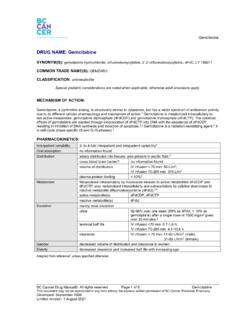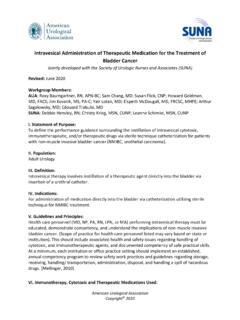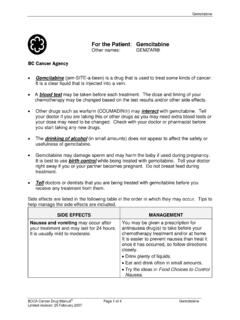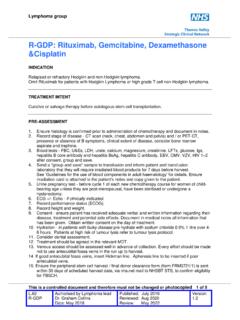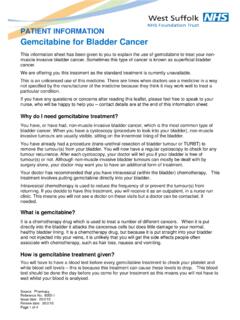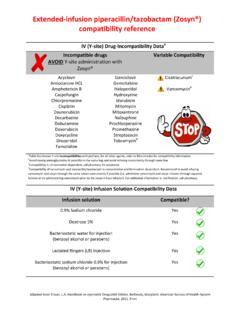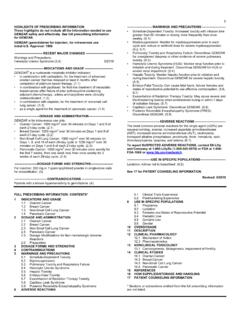Transcription of ANNEX I SUMMARY OF PRODUCT CHARACTERISTICS
1 1 ANNEX I SUMMARY OF PRODUCT CHARACTERISTICS 2 1. NAME OF THE MEDICINAL PRODUCT Abraxane 5 mg/ml powder for dispersion for infusion. 2. QUALITATIVE AND QUANTITATIVE COMPOSITION Each vial contains 100 mg of paclitaxel formulated as albumin bound nanoparticles. Each vial contains 250 mg of paclitaxel formulated as albumin bound nanoparticles. After reconstitution, each ml of dispersion contains 5 mg of paclitaxel formulated as albumin bound nanoparticles. For the full list of excipients, see section 3. PHARMACEUTICAL FORM Powder for dispersion for infusion. The reconstituted dispersion has a pH of and an osmolality of 300-360 mOsm/kg. The powder is white to yellow. 4. CLINICAL PARTICULARS Therapeutic indications Abraxane monotherapy is indicated for the treatment of metastatic breast cancer in adult patients who have failed first-line treatment for metastatic disease and for whom standard, anthracycline containing therapy is not indicated (see section ).
2 Abraxane in combination with gemcitabine is indicated for the first-line treatment of adult patients with metastatic adenocarcinoma of the pancreas. Abraxane in combination with carboplatin is indicated for the first-line treatment of non-small cell lung cancer in adult patients who are not candidates for potentially curative surgery and/or radiation therapy. Posology and method of administration Abraxane should only be administered under the supervision of a qualified oncologist in units specialised in the administration of cytotoxic agents. It should not be substituted for or with other paclitaxel formulations. Posology Breast cancer The recommended dose of Abraxane is 260 mg/m2 administered intravenously over 30 minutes every 3 weeks. Dose adjustments during treatment of breast cancer Patients who experience severe neutropenia (neutrophil count < 500 cells/mm3 for a week or longer) or severe sensory neuropathy during Abraxane therapy should have the dose reduced to 220 mg/m2 for subsequent courses.
3 Following recurrence of severe neutropenia or severe sensory neuropathy, additional 3 dose reduction should be made to 180 mg/m2. Abraxane should not be administered until neutrophil counts recover to >1500 cells/mm3. For Grade 3 sensory neuropathy, withhold treatment until resolution to Grade 1 or 2, followed by a dose reduction for all subsequent courses. Pancreatic adenocarcinoma The recommended dose of Abraxane in combination with gemcitabine is 125 mg/m2 administered intravenously over 30 minutes on Days 1, 8 and 15 of each 28-day cycle. The concurrent recommended dose of gemcitabine is 1000 mg/m2 administered intravenously over 30 minutes immediately after the completion of Abraxane administration on Days 1, 8 and 15 of each 28-day cycle. Dose adjustments during treatment of pancreatic adenocarcinoma Table 1: Dose level reductions for patients with pancreatic adenocarcinoma Dose Level Abraxane Dose (mg/m2) gemcitabine Dose (mg/m2) Full dose 125 1000 1st dose level reduction 100 800 2nd dose level reduction 75 600 If additional dose reduction required Discontinue treatment Discontinue treatment Table 2: Dose modifications for neutropenia and/or thrombocytopenia at the start of a cycle or within a cycle for patients with pancreatic adenocarcinoma Cycle Day ANC count (cells/mm3) Platelet count (cells/mm3) Abraxane Dose gemcitabine Dose Day 1 < 1500 OR < 100,000 Delay doses until recovery Day 8 500 but < 1000 OR 50,000 but < 75,000 Reduce doses 1 dose level < 500 OR < 50,000 Withhold doses Day 15: If Day 8 doses were given without modification.
4 Day 15 500 but < 1000 OR 50,000 but < 75,000 Treat with Day 8 dose level and follow with WBC Growth Factors OR Reduce doses 1 dose level from Day 8 doses < 500 OR < 50,000 Withhold doses Day 15: If Day 8 doses were reduced: Day 15 1000 AND 75,000 Return to the Day 1 dose levels and follow with WBC Growth Factors OR Treat with same doses as Day 8 500 but < 1000 OR 50,000 but < 75,000 Treat with Day 8 dose levels and follow with WBC Growth Factors OR Reduce doses 1 dose level from 4 Day 8 doses < 500 OR < 50,000 Withhold doses Day 15: IF Day 8 doses were withheld: Day 15 1000 AND 75,000 Return to Day 1 dose levels and follow with WBC Growth Factors OR Reduce doses 1 dose level from Day 1 doses 500 but < 1000 OR 50,000 but < 75,000 Reduce 1 dose level and follow with WBC Growth Factors OR Reduce doses 2 dose levels from Day 1 doses < 500 OR < 50,000 Withhold doses Abbreviations: ANC=Absolute Neutrophil Count; WBC=white blood cell Table 3: Dose modifications for other adverse drug reactions in patients with pancreatic adenocarcinoma Adverse Drug Reaction (ADR) Abraxane Dose gemcitabine Dose Febrile Neutropenia: Grade 3 or 4 Withhold doses until fever resolves and ANC 1500; resume at next lower dose levela Peripheral Neuropathy: Grade 3 or 4 Withhold dose until improves to Grade 1; resume at next lower dose levela Treat with same dose Cutaneous Toxicity: Grade 2 or 3 Reduce to next lower dose levela.
5 Discontinue treatment if ADR persists Gastrointestinal Toxicity: Grade 3 mucositis or diarrhoea Withhold doses until improves to Grade 1; resume at next lower dose levela a. See Table 1 for dose level reductions Non-small cell lung cancer: The recommended dose of Abraxane is 100 mg/m2 administered as an intravenous infusion over 30 minutes on Days 1, 8 and 15 of each 21-day cycle. The recommended dose of carboplatin is AUC = 6 mg min/mL on Day 1 only of each 21-day cycle, beginning immediately after the end of Abraxane administration. Dose adjustments during treatment of non-small cell lung cancer: Abraxane should not be administered on Day 1 of a cycle until absolute neutrophil count (ANC) is 1500 cells/mm3 and platelet count is 100,000 cells/mm3. For each subsequent weekly dose of Abraxane, patients must have an ANC 500 cells/mm3 and platelets >50,000 cells/mm3 or the dose is to be withheld until counts recover.
6 When counts recover, resume dosing the following week according to the criteria in Table 4. Reduce subsequent dose only if criteria in Table 4 are met. 5 Table 4: Dose reductions for haematologic toxicities in patients with non-small cell lung cancer Haematologic Toxicity Occurrence Dose of Abraxane (mg/m2)1 Dose of carboplatin (AUC mg min/mL)1 Nadir ANC <500/mm3 with neutropenic fever > 38 C OR Delay of next cycle due to persistent neutropenia2 (Nadir ANC <1500/mm3) OR Nadir ANC <500/mm3 for > 1 week First 75 Second 50 Third Discontinue Treatment Nadir platelets <50,000/mm3 First 75 Second Discontinue Treatment 1On Day 1 of the 21-day cycle reduce the dose of Abraxane and carboplatin simultaneously. On Days 8 or 15 of the 21-day cycle reduce the dose of Abraxane; reduce the dose of carboplatin in the subsequent cycle. 2 Maximum of 7 days post scheduled Day 1 dose of next cycle.
7 For Grade 2 or 3 cutaneous toxicity, Grade 3 diarrhoea, or Grade 3 mucositis, interrupt treatment until the toxicity improves to Grade 1, then restart treatment according to the guidelines in Table 5. For Grade 3 peripheral neuropathy, withhold treatment until resolution to Grade 1. Treatment may be resumed at the next lower dose level in subsequent cycles according to the guidelines in Table 5. For any other Grade 3 or 4 non-haematologic toxicity, interrupt treatment until the toxicity improves to Grade 2, then restart treatment according to the guidelines in Table 5. Table 5: Dose reductions for non-haematologic toxicities in patients with non-small cell lung cancer Non-haematologic Toxicity Occurrence Dose of Abraxane (mg/m2)1 Dose of carboplatin (AUC mg min/mL)1 Grade 2 or 3 cutaneous toxicity Grade 3 diarrhoea Grade 3 mucositis Grade 3 peripheral neuropathy Any other Grade 3 or 4 non-haematologic toxicity First 75 Second 50 Third Discontinue Treatment Grade 4 cutaneous toxicity, diarrhoea, or mucositis First Discontinue Treatment 1On Day 1 of the 21-day cycle reduce the dose of Abraxane and carboplatin simultaneously.
8 On Days 8 or 15 of the 21-day cycle reduce the dose of Abraxane; reduce the dose of carboplatin in the subsequent cycle. Special populations Hepatic impairment For patients with mild hepatic impairment (total bilirubin > 1 to x ULN and aspartate aminotransferase [AST] 10 x ULN), no dose adjustments are required, regardless of indication. Treat with same doses as patients with normal hepatic function. For metastatic breast cancer patients and non-small cell lung cancer patients with moderate to severe hepatic impairment (total bilirubin > to 5 x ULN and AST 10 x ULN), a 20% reduction in dose is recommended. The reduced dose may be escalated to the dose for patients with normal hepatic function if the patient is tolerating the treatment for at least two cycles (see sections and ). For patients with metastatic adenocarcinoma of the pancreas that have moderate to severe hepatic impairment, there are insufficient data to permit dosage recommendations (see sections and ).
9 For patients with total bilirubin > 5 x ULN or AST > 10 x ULN, there are insufficient data to permit dosage recommendations regardless of indication (see sections and ). 6 Renal impairment Adjustment of the starting Abraxane dose is not required for patients with mild to moderate renal impairment (estimated creatinine clearance 30 to <90 ml/min). There are insufficient data available to recommend dose modifications of Abraxane in patients with severe renal impairment or end stage renal disease (estimated creatinine clearance <30 ml/min) (see section ). Elderly No additional dosage reductions, other than those for all patients, are recommended for patients 65 years and older. Of the 229 patients in the randomized study who received Abraxane monotherapy for breast cancer, 13% were at least 65 years of age and < 2% were 75 years and older. No toxicities occurred notably more frequently among patients at least 65 years of age who received Abraxane.
10 However, a subsequent analysis in 981 patients receiving Abraxane monotherapy for metastatic breast cancer, of which 15% were 65 years old and 2% were 75 years old, showed a higher incidence of epistaxis, diarrhoea, dehydration, fatigue and peripheral oedema in patients 65 years. Of the 421 patients with pancreatic adenocarcinoma in the randomized study who received Abraxane in combination with gemcitabine , 41% were 65 years and older and 10% were 75 years and older. In patients aged 75 years and older who received Abraxane and gemcitabine , there was a higher incidence of serious adverse reactions and adverse reactions that led to treatment discontinuation (see section ). Patients with pancreatic adenocarcinoma aged 75 years and older should be carefully assessed before treatment is considered (see section ). Of the 514 patients with non-small cell lung cancer in the randomized study who received Abraxane in combination with carboplatin, 31% were 65 years or older and were 75 years or older.










